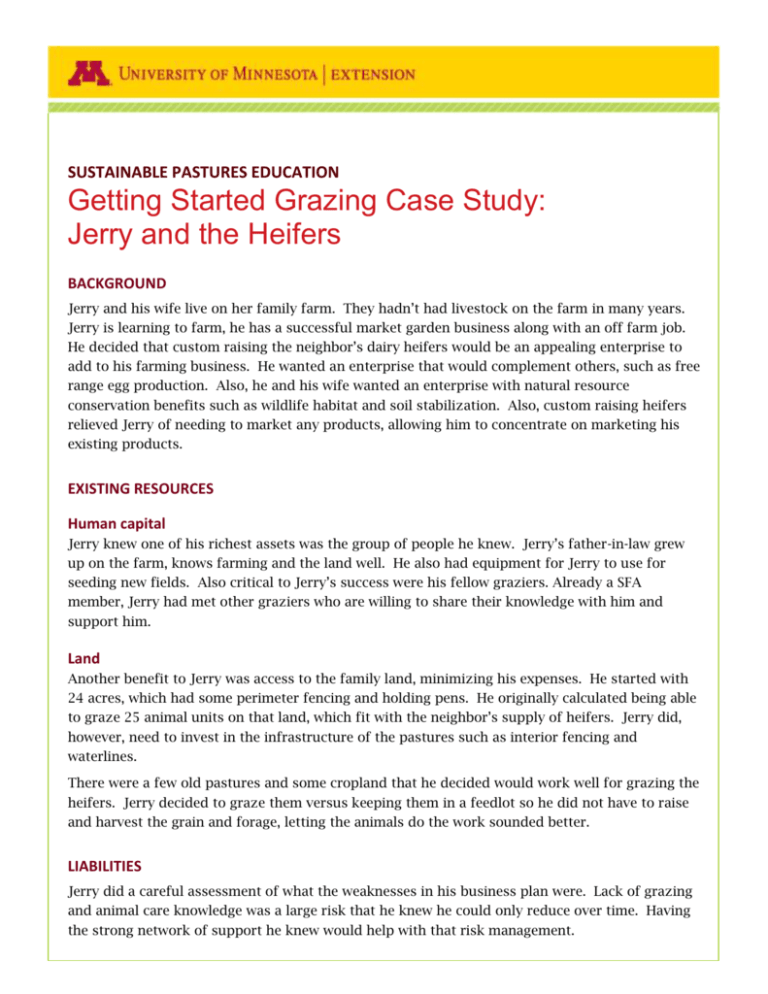
SUSTAINABLE PASTURES EDUCATION
Getting Started Grazing Case Study:
Jerry and the Heifers
BACKGROUND
Jerry and his wife live on her family farm. They hadn’t had livestock on the farm in many years.
Jerry is learning to farm, he has a successful market garden business along with an off farm job.
He decided that custom raising the neighbor’s dairy heifers would be an appealing enterprise to
add to his farming business. He wanted an enterprise that would complement others, such as free
range egg production. Also, he and his wife wanted an enterprise with natural resource
conservation benefits such as wildlife habitat and soil stabilization. Also, custom raising heifers
relieved Jerry of needing to market any products, allowing him to concentrate on marketing his
existing products.
EXISTING RESOURCES
Human capital
Jerry knew one of his richest assets was the group of people he knew. Jerry’s father-in-law grew
up on the farm, knows farming and the land well. He also had equipment for Jerry to use for
seeding new fields. Also critical to Jerry’s success were his fellow graziers. Already a SFA
member, Jerry had met other graziers who are willing to share their knowledge with him and
support him.
Land
Another benefit to Jerry was access to the family land, minimizing his expenses. He started with
24 acres, which had some perimeter fencing and holding pens. He originally calculated being able
to graze 25 animal units on that land, which fit with the neighbor’s supply of heifers. Jerry did,
however, need to invest in the infrastructure of the pastures such as interior fencing and
waterlines.
There were a few old pastures and some cropland that he decided would work well for grazing the
heifers. Jerry decided to graze them versus keeping them in a feedlot so he did not have to raise
and harvest the grain and forage, letting the animals do the work sounded better.
LIABILITIES
Jerry did a careful assessment of what the weaknesses in his business plan were. Lack of grazing
and animal care knowledge was a large risk that he knew he could only reduce over time. Having
the strong network of support he knew would help with that risk management.
Jerry also knew that time available during any given day was limited. This was due to other
obligations with other enterprises and his off-farm job. Also, he would be doing the work as other
family members were unavailable to help. So finding an enterprise and management system that
fit with his other duties daily and seasonally also was critical.
Lastly, financing was a liability as pay for the installation of the fencing challenge. Fencing is very
expensive, but Jerry knew that investing in a quality fence that was installed correctly would save
him time and money long term. To manage this, he worked with NRCS for cost share assistance
with the fencing, and only installed one of two pastures. Once the first pasture fencing was paid
off from income from the business, he could afford to install the second pasture.
STEPS TO MEET GOALS
To get started he visited friends that were graziers and read every book he could find on grazing.
Getting started grazing
Getting set up
Deciding what kind of fencing to use and where he wanted it was hard. Jerry worked with his
NRCS field staff to decide on grazing plan, do calculations, and determine what type of fencing to
use. The factors he considered in selecting fencing included; materials eligible for organic
certification, longevity of materials, ease of repair, installation cost and maintenance cost. In the
end for perimeter fencing he decided to go with a system with posts that auger into ground and
are fiberglass. He uses one strand of temporary fencing for interior paddock divisions. He can
install three lines at a time. He runs two lines between permanent fence to create a paddock, then
can add the third to make the next paddock, rotating them down a pasture.
In order to get his paddock system designed and set up, Jerry worked very closely with USDA
NRCS grazing specialists. Jerry says they made all the difference in getting started. They were
extremely valuable in walking through the calculations of number of paddocks he should have
and also made it easier to explain his plans to his partners. The neighbor who owned the cattle
and his father in law were both supportive and willing to work with him, but they didn’t know the
system. So the plans Jerry developed help everyone understand what Jerry was trying to do.
Starting to move the animals
Did it wrong at first. Listened to the old way of starting out in the spring, when the grass is up to
4 inches he turned the cattle out. The grass was not ready yet and it didn’t regrow very well. Now
he waits till a paddock is up to 12 inches and moves them when they graze it down to 6 inches.
Record keeping
Jerry has found recordkeeping very valuable for his operation. First of all, he gets paid per animal
per day, so he needs to know when and where the animals are. Also, he is required for the NRCS
EQIP and CSP programs to monitor the plants’ productivity. This has been very useful for Jerry in
determining when to stop grazing the animals in the fall. This protects the productivity of the
pastures the following season.
Where is he now?
It has gotten much easier for him to tell when to move the animals and how many animals the
land can support. He has increased his herd size from 25 to 28 head. As for his rotation scheme,
he is much more comfortable when knowing how to move the animals. Actually, since it grows so
fast in the spring, he runs the cattle the cycle of paddocks in reverse the first time in the spring,
then sends them back through the paddocks the other way the rest of the season. Now he gets
three to four rotations through his pastures each season. The first rotation takes about 25 days
through his 24 acres and the rest roughly thirty days. He is in the process of establishing more
pasture land in land that is currently in row crop production.
What changed from original plan?
One of the biggest changes from the original design is changing the layout of the paddocks from
more square to more rectangular. He said that the cattle move in them more that way, versus
standing in one spot more in square paddocks. He feels this provides more even grazing and
manure distribution. One reason Jerry was able to make this change was that his water line has
many taps on it, allowing a great deal of flexibility with his paddock design.
MORE RESOURCES
For more information on getting started with grazing and meeting other graziers can be found at
the following websites:
University of Minnesota Extension, www.extension.umn.edu
USDA NRCS in Minnesota, www.mn.nrcs.usda.gov
Sustainable Farming Association of Minnesota, www.sfa-mn.org
USDA Sustainable Agriculture Research and Education (SARE), www.sare.org
This product was developed with support from the Sustainable Agriculture Research and Education (SARE) program, which is funded by the U.S.
Department of Agriculture — National Institute of Food and Agriculture (USDA-NIFA). Any opinions, findings, conclusions or recommendations expressed
within do not necessarily reflect the view of the SARE program or the U.S. Department of Agriculture. USDA is an equal opportunity provider and employer.
© 2014 Regents of the University of Minnesota. All rights reserved. University of Minnesota Extension is an equal opportunity educator and employer.
In accordance with the Americans with Disabilities Act, this material is available in alternative formats upon request. Direct requests to efans@umn.edu.
Printed on recycled and recyclable paper with at least 10 percent postconsumer waste material.










